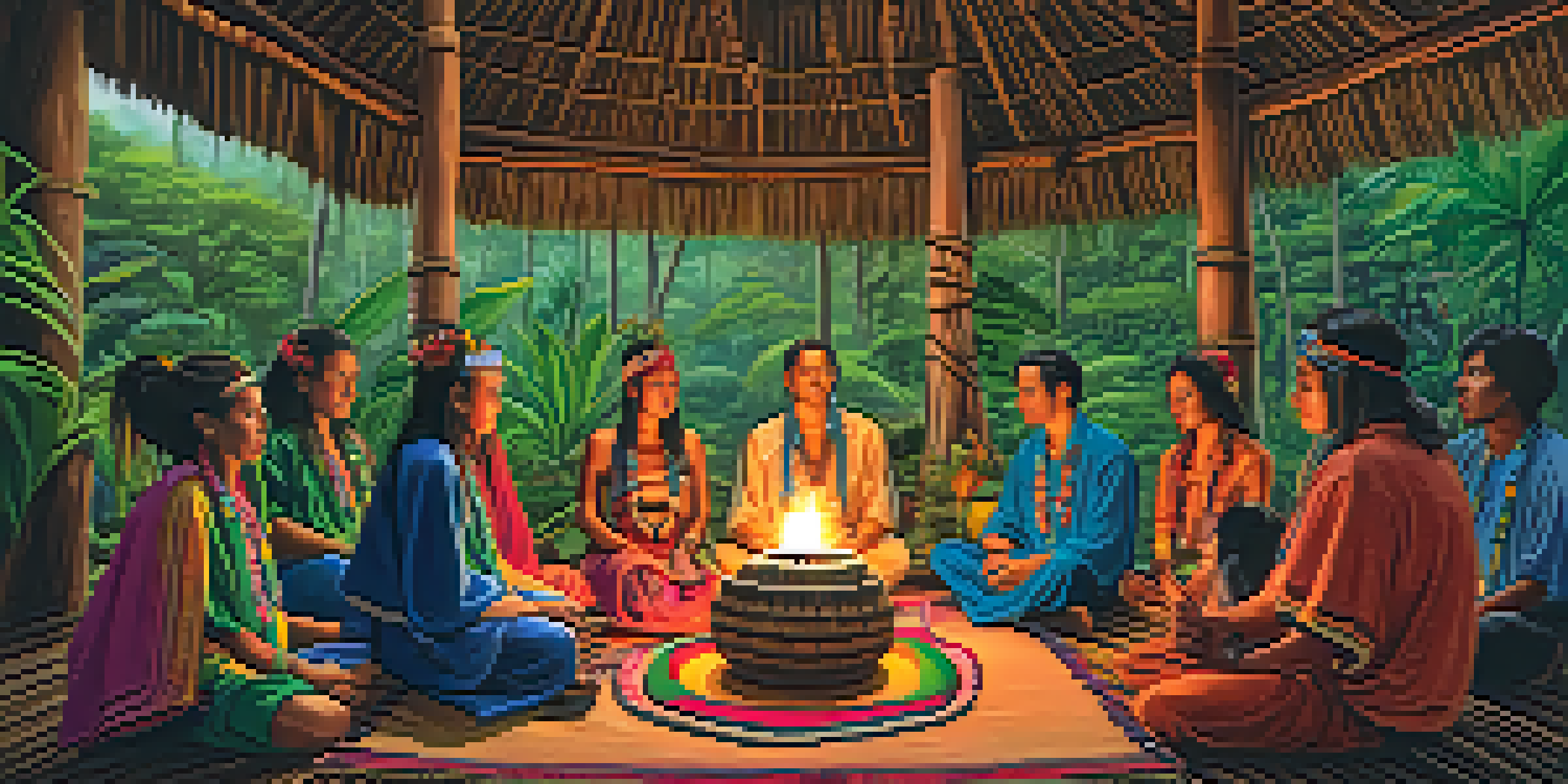Ayahuasca: A Journey through Traditional Amazonian Healing

What is Ayahuasca and Its Origins?
Ayahuasca is a powerful brew made from the Banisteriopsis caapi vine and other plants, traditionally used by Amazonian tribes for spiritual and healing purposes. It has been an integral part of their culture for centuries, often employed in shamanic rituals. The name 'Ayahuasca' translates to 'vine of the soul,' highlighting its deep spiritual significance.
The experience of Ayahuasca can lead to profound personal insights and emotional healing.
This ancient practice is not just about consuming a drink; it's about embarking on a transformative journey that can lead to profound personal insights and emotional healing. Indigenous shamans, or healers, guide participants through their experiences, helping them navigate the often intense effects of the brew. As such, Ayahuasca serves as a bridge between the physical and spiritual worlds.
In recent years, Ayahuasca has gained popularity beyond the Amazon, attracting seekers from around the globe who are looking for healing and self-discovery. However, it's essential to approach this potent substance with respect and understanding, as it carries both cultural significance and psychological weight.
The Role of Shamans in Ayahuasca Ceremonies
Shamans play a pivotal role in Ayahuasca ceremonies, acting as facilitators of the experience. They are often regarded as spiritual guides who have undergone extensive training, allowing them to navigate the complexities of the Ayahuasca journey. Their knowledge of the plants and their healing properties is essential for ensuring a safe and meaningful experience.

During a ceremony, a shaman leads participants through a structured process, often incorporating chants, songs, and rituals that enhance the effects of the brew. These elements not only provide comfort but also help participants connect with their inner selves and the larger universe. The shaman's presence is reassuring, guiding individuals through what can sometimes be challenging emotional landscapes.
Ayahuasca: A Spiritual Brew
Ayahuasca, known as the 'vine of the soul,' is a traditional Amazonian brew used for spiritual and healing purposes, guided by indigenous shamans.
Moreover, shamans are believed to have the ability to identify and address participants' specific needs, tailoring the experience accordingly. This personalized approach fosters a deep sense of trust and safety, allowing individuals to fully immerse themselves in their journey without fear.
What to Expect During an Ayahuasca Ceremony
Entering an Ayahuasca ceremony can be both exciting and intimidating. Participants typically gather in a sacred space, often under the guidance of a shaman, who creates a welcoming environment. The atmosphere is usually tranquil, with dim lights and calming sounds that encourage introspection and relaxation.
Integration is essential to ensuring the benefits of the experience extend beyond the ceremony.
Once the brew is consumed, the effects begin to unfold, often within 30 to 60 minutes. Many experience vivid visualizations, emotional release, and deep introspection. While some may find the experience euphoric, others might confront challenging emotions or memories. It's a process of purging, both physically and emotionally, which can lead to significant breakthroughs.
Throughout the ceremony, participants are encouraged to surrender to the experience and let go of any expectations. This openness can lead to insights about oneself, relationships, and life’s purpose. The journey can be deeply personal, and many individuals leave the ceremony feeling transformed, enlightened, or even healed.
The Therapeutic Benefits of Ayahuasca
Ayahuasca is increasingly recognized for its potential therapeutic benefits, with many individuals reporting significant improvements in mental health conditions like depression, anxiety, and PTSD. Research suggests that the brew may facilitate emotional healing by allowing individuals to confront and process unresolved trauma. This cathartic experience can lead to a renewed sense of hope and purpose.
The brew's psychoactive compound, DMT, is thought to play a crucial role in this healing process. It induces altered states of consciousness that can foster deep self-reflection and insight. Many participants describe feeling a sense of interconnectedness with others and the universe, which can be profoundly healing and transformative.
Shamans Facilitate Healing Journeys
Shamans play a crucial role in Ayahuasca ceremonies, providing guidance and support to participants as they navigate their transformative experiences.
Moreover, the communal aspect of Ayahuasca ceremonies contributes to the therapeutic experience. Sharing the journey with others fosters a sense of belonging and support, allowing participants to feel less isolated in their struggles. This connection can be pivotal in the healing process, reinforcing the idea that we are all in this together.
Potential Risks and Considerations
While many have experienced profound healing through Ayahuasca, it’s crucial to approach it with caution. The brew can have intense effects, both physically and psychologically, which may not be suitable for everyone. Individuals with certain medical conditions or those taking specific medications should consult a healthcare professional before participating in a ceremony.
It's also important to choose a reputable shaman and ceremony setting. The environment and guidance can significantly impact the experience, so doing thorough research is essential. A poorly executed ceremony can lead to negative experiences, which is why seeking out experienced and trustworthy facilitators is vital.
Additionally, being mentally prepared for the journey is key. It's beneficial to have an understanding of what to expect and to reflect on personal intentions before participating. This mindset can help participants navigate the challenges that may arise during the experience, ultimately leading to a more meaningful journey.
Integration: Making Sense of the Experience
After an Ayahuasca ceremony, the process of integration becomes crucial. This phase involves reflecting on the insights gained during the journey and finding ways to incorporate them into daily life. Many participants find it helpful to journal their experiences or discuss them with trusted friends or therapists to process the emotions and revelations.
Integration can also involve lifestyle changes, such as adopting healthier habits, pursuing new goals, or mending relationships. The insights gained may inspire individuals to make significant changes in their lives, fostering personal growth and well-being. This step is essential to ensuring the benefits of the experience extend beyond the ceremony.
Therapeutic Potential and Risks
While Ayahuasca shows promise for mental health treatment, it is essential to approach it with caution due to its intense effects and the need for proper guidance.
Moreover, some retreat centers offer integration support, providing resources and guidance as participants navigate their post-ceremony journey. Engaging in community discussions or support groups can further enrich the integration process, allowing individuals to share their experiences and learn from one another.
The Future of Ayahuasca in Western Culture
As interest in Ayahuasca grows in Western culture, it's essential to consider its future and how it will be integrated into our society. Many wellness retreats now offer Ayahuasca ceremonies, often blending traditional practices with modern therapeutic approaches. This fusion can create unique opportunities for healing but also raises questions about cultural appropriation and authenticity.
It's vital to respect the indigenous roots of Ayahuasca and ensure that its use is aligned with the intentions of those who have practiced it for generations. Education and dialogue between cultures can foster a deeper understanding and appreciation of Ayahuasca's origins and significance.

As research on the therapeutic potential of Ayahuasca continues to expand, we may see increased acceptance and integration of psychedelic therapies in mental health treatment. However, this must be approached with care, ensuring that the essence of traditional practices is honored while still providing individuals with the potential benefits of this ancient brew.